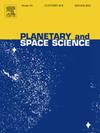Preparing for the 2061 return of Halley’s comet. A rendezvous mission with an innovative imaging system
IF 1.7
4区 物理与天体物理
Q3 ASTRONOMY & ASTROPHYSICS
引用次数: 0
Abstract
The return of Comet 1P/Halley will promote a worldwide interest for ground and space observations of a celestial body of outstanding scientific and cultural interest. In addition to remote observations, space will open the possibility of in situ study, similarly to what was done during the passage of 1986. In this paper, we first discuss the scientific motivations for a rendezvous mission capable to overcome the limitations of the flyby missions that took place at that time. In the second part, we describe an example of a rendezvous trajectory that can be carried out with existing power and propulsion technologies, i.e., with radioisotope thermoelectric generators and a Hall effect thruster. Furthermore, the transfer is made possible by the gravitational assistance of a giant planet. The resulting mission concept, nicknamed HCREM (Halley Comet REndezvous Mission), selected from a number of cases treated in a previous paper of ours (Beolchi et al., 2024), will be capable to reach the comet beyond the distance of Saturn, when the sublimation of super-volatile species (e.g. CO and CO2) will be ongoing, and well before the onset of the sublimation of water (expected to occur around 4 AU, namely at larger heliocentric distance than Mars). Following a direct transfer from Earth, a gravity assist with Jupiter inserts the spacecraft into the cometary orbital plane with retrograde motion. Electric propulsion modifies the trajectory so that the spacecraft reaches the target with zero relative velocity. After the rendezvous, the spacecraft will accompany the comet before, around and after perihelion, which will happen in July 2061, until the outbound crossing of the ecliptic and possibly even later. Given the large heliocentric distances reached by the spacecraft, our concept mission does not foresee the implementation of solar panels. In this way, some shortcomings deriving from the adoption of this technology onboard the Rosetta mission to comet 67P are avoided and operations can occur even inside the dense dust coma at short distance from the nucleus. In the third part of the paper, an innovative imaging system with a very large field of view of approximately 100°is proposed. This optical system allows the simultaneous capture of both details of the cometary surface and the surrounding space within a single image frame. For several degrees outside the borders of the nucleus, it allows following the trajectories of chunks and clouds ejected by pits or fractures, all phenomena crucial to the understanding of the cometary activity. In the conclusions, we stress that a concerted effort is needed in the current decade to plan and approve a rendezvous mission to 1P. Indeed, the scenario here described requires launching before 2040, less than 15 years from now. Later launches with existing rockets imply a severe loss of scientific knowledge, because the spacecraft will not be able to reach the comet before the onset of water sublimation.

准备2061年哈雷彗星的回归。用创新成像系统进行交会任务
彗星1P/哈雷的回归将促进全世界对这一具有突出科学和文化意义的天体进行地面和空间观测的兴趣。除了远程观测之外,空间将使实地研究成为可能,就象1986年期间所做的那样。在本文中,我们首先讨论了能够克服当时发生的飞越任务的局限性的交会任务的科学动机。在第二部分中,我们描述了一个可以使用现有动力和推进技术进行交会轨迹的例子,即使用放射性同位素热电发电机和霍尔效应推进器。此外,这种转移是在一颗巨大行星的引力协助下实现的。由此产生的任务概念,绰号HCREM(哈雷彗星交会任务),从我们之前的一篇论文(Beolchi等人,2024年)中处理的一些案例中选择,将能够到达土星以外的彗星,当超挥发性物质(例如CO和CO2)的升华将继续进行,并且在水的升华开始之前(预计发生在4个天文单位左右,即比火星更大的日心距离)。在从地球直接转移之后,木星的重力辅助将航天器以逆行运动插入彗星轨道平面。电力推进改变轨道,使航天器以零相对速度到达目标。交会之后,探测器将在2061年7月的近日点前后和前后陪伴彗星,直到出站穿越黄道,甚至可能更晚。考虑到航天器到达日心的距离很大,我们的概念任务并没有预见到太阳能电池板的实施。通过这种方式,可以避免罗塞塔号67P彗星任务中采用这种技术带来的一些缺点,甚至可以在距离彗核很近的密集尘埃昏迷中进行操作。在论文的第三部分,提出了一种具有大约100°的超大视场的创新成像系统。这种光学系统允许在一个图像框架内同时捕捉彗星表面和周围空间的细节。在彗核边界外几度的范围内,它可以跟踪由凹坑或裂缝喷出的大块和云的轨迹,这些现象对理解彗星的活动至关重要。在结论中,我们强调,在目前的十年中需要作出协调一致的努力来规划和批准前往p的会合任务。事实上,这里描述的情景需要在2040年之前发射,距离现在不到15年。用现有的火箭晚些时候发射意味着科学知识的严重损失,因为航天器将无法在水升华开始之前到达彗星。
本文章由计算机程序翻译,如有差异,请以英文原文为准。
求助全文
约1分钟内获得全文
求助全文
来源期刊

Planetary and Space Science
地学天文-天文与天体物理
CiteScore
5.40
自引率
4.20%
发文量
126
审稿时长
15 weeks
期刊介绍:
Planetary and Space Science publishes original articles as well as short communications (letters). Ground-based and space-borne instrumentation and laboratory simulation of solar system processes are included. The following fields of planetary and solar system research are covered:
• Celestial mechanics, including dynamical evolution of the solar system, gravitational captures and resonances, relativistic effects, tracking and dynamics
• Cosmochemistry and origin, including all aspects of the formation and initial physical and chemical evolution of the solar system
• Terrestrial planets and satellites, including the physics of the interiors, geology and morphology of the surfaces, tectonics, mineralogy and dating
• Outer planets and satellites, including formation and evolution, remote sensing at all wavelengths and in situ measurements
• Planetary atmospheres, including formation and evolution, circulation and meteorology, boundary layers, remote sensing and laboratory simulation
• Planetary magnetospheres and ionospheres, including origin of magnetic fields, magnetospheric plasma and radiation belts, and their interaction with the sun, the solar wind and satellites
• Small bodies, dust and rings, including asteroids, comets and zodiacal light and their interaction with the solar radiation and the solar wind
• Exobiology, including origin of life, detection of planetary ecosystems and pre-biological phenomena in the solar system and laboratory simulations
• Extrasolar systems, including the detection and/or the detectability of exoplanets and planetary systems, their formation and evolution, the physical and chemical properties of the exoplanets
• History of planetary and space research
 求助内容:
求助内容: 应助结果提醒方式:
应助结果提醒方式:


